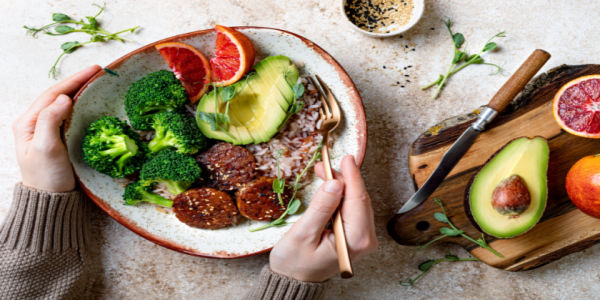
Individuals mostly desire weight loss to look and feel their best. However, we must not forget about the repercussions of a large waistline. In fact, an increased waist circumference increases the risk of metabolic syndrome, a cluster of conditions shown to increase the risk of heart disease, stroke, and diabetes.
And while weight gain and loss has multiple causes, identifying these 10 best and worst foods for belly fat can reduce risk of disease, and initiate a happier, healthier you!
10 Best & Worst Foods for Your Waistline
From added sugars to fresh fruits and veggies, bistroMD is here to help you navigate the best and worst foods for your waistline!
Worst Foods for Belly Fat
1. Refined Grains
Refined grains are considerably processed compared to its whole grain counterpart. Simply put, refined grains are stripped down variations of whole grains, ultimately loosing valuable nutrients and essentially being no more than a rich carb source.
Refined products mostly include white flours and the sources they transpire into, including white bread, pasta, and pastries.
2. Added Sugars
When it comes to added sugar intake, the general population is consuming too much of it.
The American Heart Association (AHA) recommends men and women consume no more than nine and six teaspoons of added sugars per day, respectively. However, more than 70 percent of the U.S. population consumes more than 22 grams per day!
Added sugars have a tremendous concern related to weight gain and a plethora of chronic diseases. Obvious added sugar products comprise sodas, cakes, cookies, and other pastries and sweet treats.
However, perceived "healthy” choices may also contain a large amount of added sugars, including flavored yogurt, granola and granola bars, and tomato sauces.
3. Natural and Artificial Sweeteners
Individuals tend to believe slapping on "naturally-sweetened" onto food products translates to a more healthful, less sugar-filled product. However, sugar still is sugar, even in its more natural forms of honey and agave.
It is still imperative to visualize natural sweeteners as added sugar and remain mindful of their intake. And though choosing artificial sweeteners appears to naturally cut calorie and sugar content, research suggests their intake may do more harm than good.
In fact, data suggests their use may even cause weight gain!

4. Margarine
Margarine may just be one of the most primary fatty foods to avoid, primarily related to its robust trans fat content.
But the worry of trans fat is not new, as its harmful consequences have been linked to health concerns. These include weight gain around the belly.
In addition to margarine, stay cautious of these top five foods for trans fats.
5. Alcohol
Though not a food per se, alcohol can lead to unwanted weight gain.
Alcohol supplies calories as is, and mix it with sugary mixers and syrups, a single drink can pour out hundreds of calories.
What's more, cravings towards innutritious foods tend to be heightened following a drinking bender.
If deciding to drink, do so in moderation. Men should stick to no more than two servings daily, while women are limited to one. Also be mindful of mixers added, including those with added sugars.
Best Foods for Your Waistline
6. Whole Grains
Compared to refined grains, whole grains are rich in fiber and valuable vitamins. Oats, for example, are a renowned fiber source and help initiate satiety, or feelings of fullness.
Health experts continually advocate for increased fiber intake, as the general population falls considerably shy at the 25 to 38-gram recommendation.
Research has shown individuals with a high fiber intake maintain a healthy body mass index compared to individuals who fall short of the fiber recommendation.
7. Lean Proteins
Protein is important for weight loss. Lean proteins are extensively promoted, as they tend to be lower in fat and sodium compared to prepackaged meats such as hot dogs and sausages.
Plant-based proteins are also encouraged, as they may be ample in both protein and fiber. Valuable protein sources include chicken, lean beef, quinoa, and beans.
8. Fruits and Veggies
Although the importance of produce generally goes without saying, it really cannot be stressed enough.
Unlike most other foods groups, non-starchy veggies (including cruciferous and green, leafy veggies) are encouraged in excess, as they supply fiber and rich nutrients without great concern of contributing large calorie loads.
Though fruit intake should be slightly moderated, their naturally sweet flavor can satisfy that stubborn sweet tooth while supplying fiber and nutrients. Find a more comprehensive guide to the 20 best and worst low-carb fruits here.
9. Healthy Fats
Unlike trans and saturated fats, unsaturated fats are encouraged for overall total health. Monounsaturated (MUFAs) and polyunsaturated fatty acids (PUFAs) are considered to be those so-called "healthy" fats.
They are mostly found in plant-based products, though fatty fish are an exceptional omega-3 fatty acid source, a form of PUFA.
Healthy fats can offer satiation to meals, ultimately reducing the risk of overeating on large or second portions.
10. Yogurt
Dairy products tend to have a bad reputation, especially when fueled by the evolving research of low-fat versus full-fat milk.
But whether traditional or Greek, research implies yogurt can actually provoke weight loss. Particularly important in choosing yogurt, though, is straying away from flavored types that are mostly loaded with added, unnecessary sugars.






